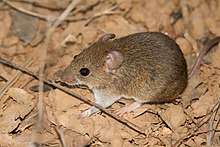Necromys
Necromys is a genus of South American sigmodontine rodents allied to Akodon.[1] This genus has also been known as Cabreramys or more recently Bolomys, and the northern grass mouse (N. urichi) has recently been transferred from Akodon.
| Necromys Temporal range: Late Pliocene–Recent | |
|---|---|
 | |
| Hairy-tailed bolo mouse (Necromys lasiurus) | |
| Scientific classification | |
| Kingdom: | Animalia |
| Phylum: | Chordata |
| Class: | Mammalia |
| Order: | Rodentia |
| Family: | Cricetidae |
| Subfamily: | Sigmodontinae |
| Tribe: | Akodontini |
| Genus: | Necromys Ameghino 1889 |
| Species | |
| |
| Synonyms | |
| |
History
Most of the Brazilian members of the genus Necromys were first described in the second half of the nineteenth century, and the species from the Andes followed in the first decades of the twentieth century.[2] Small rodents in South America were studied by the British zoologist Oldfield Thomas, curator at the Natural History Museum, London who erected the genus Bolomys in 1916.[3]
Characteristics
Members of the genus Necromys are spread out over a wide area of Central and South America. Morphologically, members of the genus are difficult to distinguish from two other genera found in the same region, the grass mice Akodon and the cane mice Zygodontomys.[2] In 1987, the Argentine zoologist Osvaldo Reig listed the characteristics that distinguished the genus Bolomys from Akodon as; the braincase is broad and deep; the occipital region is short; the rostrum is fairly short; the rostrum tapers forwards when viewed from the side; the occiput is short and truncated; the zygomatic plate is broad, with the front edge straight or slightly concave; the upper incisors are orthodont or proodont; the molars are mesodont, broad and robust; the upper molars have transverse loops; and the lower molars have the lingual cusps slightly in front of the labial cusps.[3]
There is very little variation in the karyotype of Necromys, where 2n=34 is the rule, with N. lactens and N. lasiurus having diploid numbers of 2n=36. This is in great contrast to the explosively radiating Akodon which has diploid numbers ranging from 2n=14 to 2n=52.[4]
Species
Species listed in Necromys include:
- N. amoenus Pleasant bolo mouse
- N. benefactus Argentine bolo mouse
- N. lactens Rufous-bellied bolo mouse
- N. lasiurus Hairy-tailed bolo mouse
- N. lenguarum Paraguayan bolo mouse
- N. lilloi[5]
- N. obscurus Dark bolo mouse
- N. punctulatus Spotted bolo mouse
- N. temchuki Temchuk's bolo mouse
- N. urichi Northern grass mouse
- †N. bonapartei, Monte Hermoso Formation (Montehermosan)[6]
References
- Musser, G.G.; Carleton, M.D. (2005). "Superfamily Muroidea". In Wilson, D.E.; Reeder, D.M (eds.). Mammal Species of the World: A Taxonomic and Geographic Reference (3rd ed.). Johns Hopkins University Press. pp. 1130–1131. ISBN 978-0-8018-8221-0. OCLC 62265494.
- Patton, James L. (2015). Mammals of South America, Volume 2: Rodents. University of Chicago Press. pp. 232–235. ISBN 978-0-226-16957-6.
- Eisenberg, John F.; Redford, Kent H. (1992). Mammals of the Neotropics, Volume 2: The Southern Cone: Chile, Argentina, Uruguay, Paraguay. University of Chicago Press. p. 316. ISBN 978-0-226-70682-5.
- Fontdevila, Antonio (2012). Evolutionary Biology of Transient Unstable Populations. Springer Science & Business Media. pp. 270–271. ISBN 978-3-642-74525-6.
- Jayat, J.P. et al. (September 2016). "A new species of the rodent genus Necromys Ameghino (Cricetidae: Sigmodontinae: Akodontini) from the Chaco Serrano grasslands of northwestern Argentina". Journal of Mammalogy. 97 (5): 1321–1335. doi:10.1093/jmammal/gyw103.CS1 maint: uses authors parameter (link)
- Farola Monte Hermoso FI Facies at Fossilworks.org